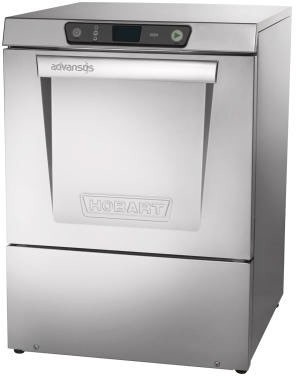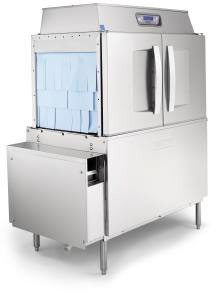6.9 Commercial Kitchen Equipment
Dishwashers
All dishwashing machines employ wash, rinse, and sanitizing cycles. The sanitizing cycle typically is the chemical reduction of micro micro organisms to safe levels on any food utensil. The time taken for a dishwasher to complete a cycle is a combination of mechanical action, water temperature, and chemical action. Most dishwashers use between 2.0 and 7.0 GPM for a complete cycle of cleaning and sanitation. The amount of hot water varies with the pressure of supply lines, operation speed of the machine, and dish table layout. All these variables are intrinsically linked and any adjustments affect each component. For example, rapid washing cycles necessitate stronger mechanical action and more concentrated detergents for cleaning.
Types of dishwashing machines
There are four main types of dishwashing machines, under-counter, door, conveyor, and flight. A wide array of models and accessories are available for each category.
Requirements for machine size can be calculated by estimating the amount of traffic that will be served in the food service area. Energy guidelines and water consumption levels for dishwashers are becoming stricter, and many manufacturers offer new water-saving models.
 |
 |
 |
DOOR TYPE
Manufactured to service 50-200 people, door type machines are the most widely used of commercial dishwashing machines. Door machines are used in schools, hospitals, churches, restaurants, catering businesses, fast-food establishments, and as glass and utensil units in larger operations. These box-shaped machines have singular or multiple doors that slide vertically for loading and unloading. Door type machines are available in high temperature and chemical sanitizing models. These “dump and rinse” machines have a single tank for water and detergent, which are circulated in measured volumes and temperatures Two revolving spray arms (one above and one below the dish rack) distribute wash solutions evenly over the dishes. Some door type machines now have the ability to recycle rinse water to be used again in a wash cycle.
C-LINE CONVEYOR, RACK
C line, or rack conveyor, machines use a motor-driven conveyor belt to move the rack loaded dishes through a large tank with separate wash and rinse compartments Most widely-used in hotels, large restaurants, hospitals, schools, and universities , these machines are well suited for service of 200 or more people, accommodating most heavy food service operations come in varying sizes, with available additions such as pre wash units, side-loading trays, condensers, and blower-dryers A single tank holds the water and detergent at a regulated temperature water and detergent at a regulated temperature The wash solution is pumped through multiple spray arms (revolving or stationary) that run constantly once the machine is operational, regardless the presence of a dish rack The rack is then sent through the rinse compartment, where it is sprayed with the 180 F water by spray nozzles above and below the rack.
C line machines with multiple tanks differ in that some use stationary versus rotating spray arms. The racks then are sent into a pump-driven rinse tank that rinses the dishes heavily. This process usually uses recycled water from the final rinse. All rack conveyor machines have a timer control for the speed of the conveyor to assure proper wash and rinse times.
Image Credits
- Hobart. (n.d.). LXeR Advansys two-level undercounter dishwasher. https://www.hobartcorp.com/products/commercial-dishwashers/undercounter/hobart-advansys-lxer-undercounter-dishwasher
- Hobart. (n.d.). AM16 Advansys door type commercial dishwasher. https://www.hobartcorp.com/products/commercial-dishwashers/undercounter/hobart-am16advansys-door-type-commercial-dishwasher
- Hobart. (n.d.). CLeN Advansys conveyor type commercial dishwasher. https://www.hobartcorp.com/products/commercial-dishwashers/conveyor-type/clen-advansys-conveyor-type
